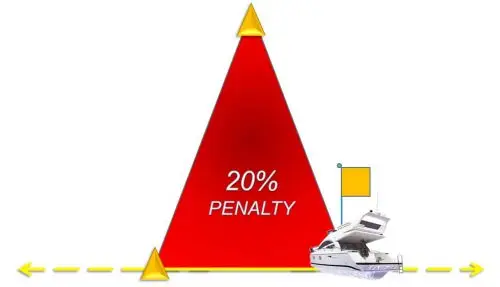Often, we focus our rules discussions only on Part 2 of the rules – “When Boats Meet.” This winter, I plan to explore the rules of Part 3 – “Conduct of a Race.” They may appear to only matter to the Race Committee, but they have significant importance to the racing sailor too.
– Steve Harris, US Sailing National Race Officer
Rule 30 - Starting Penalties
30.2 - Z Flag Rule
“If flag Z has been displayed, no part of a boat’s hull shall be in the triangle formed by the ends of the starting line and the first mark during the last minute before her starting signal. If a boat breaks this rule and is identified, she shall receive, without a hearing, a 20% Scoring Penalty calculated as stated in rule 44.3(c). She shall be penalized even if the race is restarted or re-sailed, but not if it is postponed or abandoned before the starting signal. If she is similarly identified during a subsequent attempt to start the same race, she shall receive an additional 20% Scoring Penalty. “

– Overheard on a Race Committee Boat several years back.
Remember: Just as with the previous rules we’ve discussed, this rule changed slightly in 2021. It used to refer to any part of the boat’s hull, crew, or equipment. In order to clarify both the start and the finish, these definitions were changed to just the hull as it is easier to define and less potentially subjective.
Just as with Rule 30.1, Rule 30.2 applies to the last minute of the starting sequence. It’s primary function is also to help the RC to control aggressive starts.
Also, like we saw in Rule 30.1, to invoke this rule, the RC will display Flag Z instead of Flag P in the standard starting sequence (RRS 26)
So... What's Different?
Let's Break it Down...
“…no part of a boat’s hull shall be in the triangle formed by the ends of the starting line and the first mark during the last minute before her starting signal…”
Where Rule 30.1 referred to the line, and it’s extensions, this rule defines a new “No-Go” area – “The Triangle”

This is different and certainly requires more attentiveness (and personnel) on the part of the race committee. Now, instead of only being concerned with the starting line (or the line and it’s extensions), the “No-Go” area encompasses a large area of the course. Ideally, the RC has people on the RC signal boat looking both at the pin end of the line and upcourse at the windward mark, others on the pin end of the line watching the RC end of the line and upcourse at the the windward mark, and still more at the windward mark sighting down to both ends of the starting line. It can get quite cumbersome. For these reasons, typically – certainly for club-level racing – the RC would go to Rule 30.1 first and if that doesn’t work, maybe escalate to Rule 30.2 (or a combination of the two).
But… remember it is the competitors’ responsibility to start properly! This “No-Go” area is even more difficult (if not impossible) to properly sight on a moving boat – especially during the hectic last minute of the starting sequence.
“…If a boat breaks this rule and is identified, she shall receive, without a hearing, a 20% Scoring Penalty calculated as stated in rule 44.3(c)… “
Another major difference is that if you are guilty of breaking this rule, you cannot avoid the penalty. (although you are still required to start properly even if you violated the rule). “Shall” is prescriptive. Even if the RC wanted to “let it go,” the rules require them to apply the penalty. (See WS Case #111)
“… as stated in rule 44.3(c)… “
Calculating the penalty can get tricky. The important thing to know about it as a racer is to know where to look to see how it was calculated – mistakes sometimes happen.

